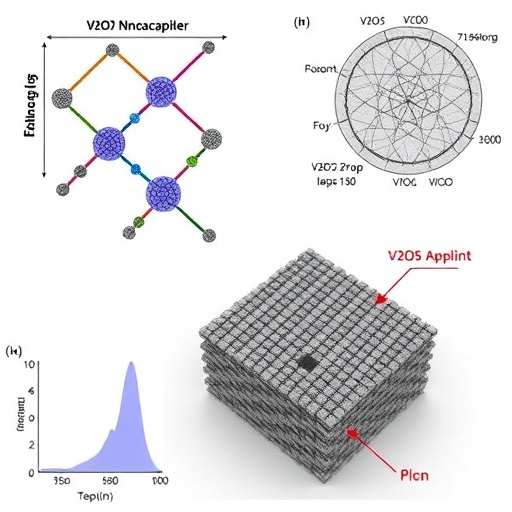In the pursuit of advanced energy storage solutions, researchers are increasingly drawn to the utilization of nanocomposites due to their enhanced electrochemical properties. A recent study conducted by a team of scientists, including Vijayakumar, Gomathi, and Manikandan, has focused on the synthesis and characterization of a Vanadium Pentoxide (V2O5) and Nickel Oxide (NiO) nanocomposite, revealing its significant potential in supercapacitor applications. This breakthrough not only showcases the remarkable performance of such nanocomposites but also hints at future advancements in sustainable energy technologies.
The study begins with a comprehensive overview of the current state of energy storage systems, particularly the limitations of conventional batteries. It highlights the essential batteries and supercapacitors play in modern society, particularly in electric vehicles and portable electronics. The researchers detail the challenges that electric vehicles face, including energy density, charge/discharge efficiency, and lifespan. Consequently, there is an urgent demand for materials that exhibit high capacitance and outstanding cycling stability.
At the core of the tackled problem lies the inefficiency of current storage systems. Traditional supercapacitors have a lower energy density compared to batteries, which limits their application in the energy landscape. However, integrating V2O5 with NiO brings forth a promising solution that capitalizes on the unique properties of both materials, creating a nanocomposite capable of overcoming existing barriers associated with energy storage mediums.
Vanadium Pentoxide is noted for its remarkable electrochemical properties, which stem from its layered structure that facilitates the rapid movement of ions. Concurrently, Nickel Oxide is recognized for its excellent electrical conductivity and stability. The synergistic effects of these two components within a nanocomposite framework can significantly enhance capacitance and overall electrochemical performance, a vital attribute for supercapacitors intended for high-energy storage applications.
The synthesis process of the V2O5/NiO nanocomposite is meticulously detailed, outlining the techniques employed by the researchers. They utilized a straightforward yet efficient method to produce the nanocomposite, maximizing the interaction between the two components at the nanoscale. Characterization techniques, including X-Ray Diffraction (XRD), Scanning Electron Microscopy (SEM), and Transmission Electron Microscopy (TEM), are employed to confirm the successful formation and uniform distribution of the nanoparticles within the composite. These characterizations are critical as they validate the structural integrity and homogeneity of the synthesized materials.
Electrochemical testing follows, where the team employs methods like cyclic voltammetry and galvanostatic charge-discharge tests to evaluate the performance of the nanocomposite. The impressive results obtained indicate that the V2O5/NiO nanocomposite exhibits high specific capacitance and excellent cycling stability, surpassing that of pure V2O5 and NiO electrodes. These findings hold significant implications for the feasibility of using such materials in commercial supercapacitors, particularly those demanding high performance.
Further examination delves into the underlying mechanisms that contribute to the superior electrochemical performance of the V2O5/NiO nanocomposite. The study emphasizes how the interface between V2O5 and NiO promotes superior electron transfer and ion diffusion pathways, resulting in enhanced charge storage capabilities. Additionally, the researchers hypothesize that the reformulated nanocomposite architecture enables better structural integrity during cycling, reducing the likelihood of degradation, thus extending the lifespan of the supercapacitor.
The implications of this research extend to several sectors, emphasizing the importance of innovative energy storage solutions in combatting climate change and promoting sustainable practices. As energy consumption continues to rise globally, adopting more efficient and sustainable energy storage technologies becomes paramount to meeting future demands. Supercapacitors, with their fast charging capabilities and long life cycles, may prove essential for renewable energy applications, such as solar and wind energy systems, thereby supporting a greener future.
Moreover, the potential commercialization of the V2O5/NiO nanocomposite in the realm of supercapacitors presents exciting opportunities for industries focused on developing high-performance energy storage devices. With continuous advancements in nanotechnology and materials science, the research team aspires that this work paves the way for further investigations into similar nanocomposites that can cater to diverse applications, particularly in electric vehicles and consumer electronics.
As the demand for efficient and high-capacity energy storage solutions increases, the implications of the findings from this research extend far beyond academics. The synthesis and utilization of V2O5/NiO nanocomposite could inspire a wave of innovations in energy storage technologies and related fields. More importantly, the collaboration amongst experts emphasizes a proactive approach to addressing energy challenges in an ever-evolving technological landscape.
Ultimately, the study contributes valuable knowledge and operational frameworks essential for the future development of innovative electrochemical devices. Through their meticulous research, the authors open doors to an array of possibilities that could significantly reshape our approach to energy storage and management.
In conclusion, the findings of Vijayakumar, Gomathi, and Manikandan signify a pivotal advancement in the field of energy storage. The vibrant outlook for V2O5/NiO nanocomposites in supercapacitor applications reflects not merely academic enthusiasm but also hints at transformative changes awaiting industries focused on sustainable energy solutions. Hence, continued research in this domain will be instrumental in ensuring that future energy demands are met with innovative and efficient technologies.
Subject of Research: Synthesis and Electrochemical Performance of V2O5/NiO Nanocomposite for Supercapacitors
Article Title: Investigation on the electrochemical performance of V2O5/NiO nanocomposite for supercapacitors.
Article References: Vijayakumar, P., Gomathi, A., Manikandan, S. et al. Investigation on the electrochemical performance of V2O5/NiO nanocomposite for supercapacitors. Ionics (2025). https://doi.org/10.1007/s11581-025-06750-y
Image Credits: AI Generated
DOI: https://doi.org/10.1007/s11581-025-06750-y
Keywords: V2O5, NiO, nanocomposite, supercapacitors, electrochemical performance, energy storage.




